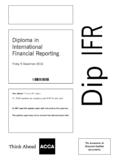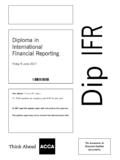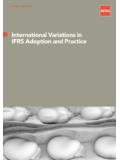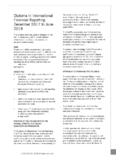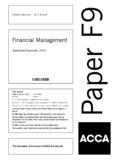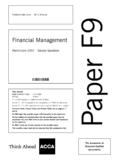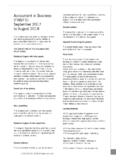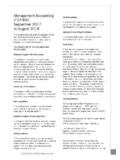Transcription of BUSINESS COMBINATIONS: IFRS 3 (REVISED)
1 Technical page 50student accountantfebruarY 2009 RELEVANT TO ACCA QUALIFICATION PAPER P2 IFRS 3 (Revised), BUSINESS Combinations, will result in significant changes in accounting for BUSINESS combinations. IFRS 3 (Revised) further develops the acquisition model and applies to more transactions, as combinations by contract alone and of mutual entities are included in the standard. Common control transactions and the formation of joint ventures are not dealt with by the standard. IFRS 3 (Revised) affects the first accounting period beginning on or after 1 July 2009. It can be applied early, but only to an accounting period beginning on or after 30 June 2007.
2 Importantly, retrospective application to earlier BUSINESS combinations is not CONSIDERATIONSome of the most significant changes in IFRS 3 (Revised) are in relation to the purchase consideration, which now includes the fair value of all interests that the acquirer may have held previously in the acquired BUSINESS . This includes any interest in an associate or joint venture, or other equity interests of the acquired BUSINESS . Any previous stake is seen as being given up to acquire the entity, and a gain or loss is recorded on its disposal. If the acquirer already held an interest in the acquired entity before acquisition, the standard requires the existing stake to be re-measured to fair value at the date of acquisition, taking into account any movement to the income statement together with any gains previously recorded in equity that relate to the existing holding.
3 If the value of the stake has increased, there will be a gain recognised in the statement of comprehensive income (income statement) of the acquirer at the date of the BUSINESS combination. A loss would only occur if the existing interest has a book value in excess of the proportion of the fair value of the BUSINESS obtained and no impairment had been recorded previously. This loss situation is not expected to occur requirements for recognition of contingent consideration have been amended. Contingent consideration now has to be recognised at fair value even if payment is not deemed to be probable at the date of the acquisition.
4 EXAMPLE 1 Josey acquires 100% of the equity of Burton on 31 December 2008. There are three elements to the purchase consideration: an immediate payment of $5m, and two further payments of $1m if the return on capital employed (ROCE) exceeds 10% in each of the subsequent financial years ending 31 December. All indicators have suggested that this target will be met. Josey uses a discount rate of 7% in any present value :Determine the value of the two payments that are conditional upon reaching the target ROCE are contingent consideration and the fair value of $(1 + 1 ) ie $ will be added to the immediate cash payment of $5m to give a total consideration of $ subsequent changes in debt-contingent consideration are recognised in the income statement, rather than against goodwill, as they are deemed to be a liability recognised under IAS 32/39.
5 An increase in the liability for good performance by the subsidiary results in an expense in the income statement, and under-performance against targets will result in a reduction in the expected payment and will be recorded as a gain in the income statement. These changes were previously recorded against nature of the contingent consideration is important as it may meet the definition of a liability or equity. If it meets the definition of an equity, then there will be no re-measurement as per IAS 32/39. The new requirement is that contingent consideration is fair valued at acquisition and, unless it is equity, is subsequently re-measured through earnings rather than the historic practice of re-measuring through goodwill.
6 This change is likely to increase the focus and attention on the opening fair value calculation and subsequent standard also requires any gain on a bargain purchase (negative goodwill) to be recorded in the income statement, as in the previous standard. Transaction costs no longer form a part of the acquisition price; they are expensed as incurred. Transaction costs are not deemed to be part of what is paid to the seller of a BUSINESS . They are also not deemed to be assets of the purchased BUSINESS that should be recognised on acquisition. The standard requires entities to disclose the amount of transaction costs that have been first article in a two-part series provides an introduction to IFRS 3 and IAS 27, including piecemeal acquisitions and disposals.
7 The second article in the April 2009 issue of student accountant will tackle complex COMBINATIONS : IFRS 3 (REVISED)technical page 51 The standard clarifies accounting for employee share-based payments by providing additional guidance on valuation, as well as on how to decide whether share awards are part of the consideration for the BUSINESS combination or are compensation for future services. GOODWILL AND NON-CONTROLLING INTERESTS (NCIs)The revised standard gives entities the option, on an individual transaction basis, to measure NCIs (minority interests) at the fair value of their proportion of identifiable assets and liabilities, or at full fair value.
8 The first method will result in the measurement of goodwill, a process which is basically the same as in the existing IFRS. However, the second method will record goodwill on the NCI as well as on the acquired controlling interest. Goodwill continues to be a residual but it will be a different residual under IFRS 3 (Revised) if the full fair value method is used as compared to the previous standard. This is partly because all of the consideration, including any previously held interest in the acquired BUSINESS , is measured at fair value, but it is also because goodwill can be measured: as the difference between the consideration paid and the purchaser s share of identifiable net assets acquired: this is a partial goodwill method because the NCI is recognised at its share of identifiable net assets and does not include any goodwill on a full goodwill basis: this means that goodwill is recognised for the NCI in a subsidiary as well as the controlling interest.
9 EXAMPLE 2 Missile acquires a subsidiary on 1 January 2008. The fair value of the identifiable net assets of the subsidiary were $2,170m. Missile acquired 70% of the shares of the subsidiary for $ The NCI was fair valued at $ :Compare the value of goodwill under the partial and full based on the partial and full goodwill methods under IFRS 3 (Revised) would be:Partial goodwill $mPurchase consideration 2,145 Fair value of identifiable net assets (2,170)NCI (30% x 2,170) 651 Goodwill 626 Full goodwill $mPurchase consideration 2,145 NCI 683 2,828 Fair value of identifiable net assets (2,170)Goodwill 658It can be seen that goodwill is effectively adjusted for the change in the value of the NCI, which represents the goodwill attributable to the NCI of $32m ($658m - $626m).
10 Choosing this method of accounting for NCI only makes a difference in an acquisition where less than 100% of the acquired BUSINESS is purchased. The full goodwill method will increase reported net assets on the balance sheet, which means that any future impairment of goodwill will be greater. Although measuring NCI at fair value may prove difficult, goodwill impairment testing is likely to be easier under full goodwill, as there is no need to gross-up goodwill for partially owned subsidiaries. FAIR VALUING ASSETS AND LIABILITIESIFRS 3 (Revised) has introduced some changes to the assets and liabilities recognised in the acquisition balance sheet.

